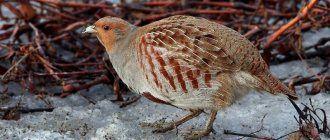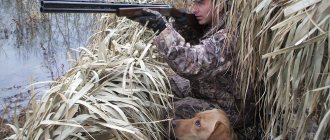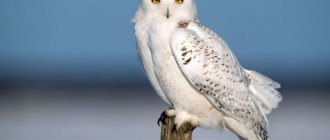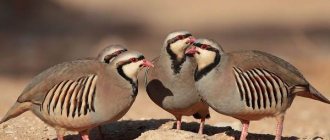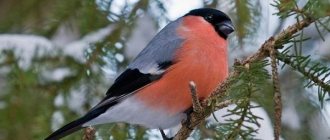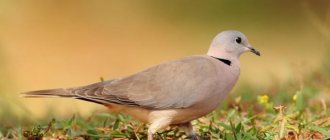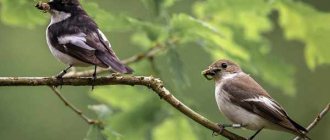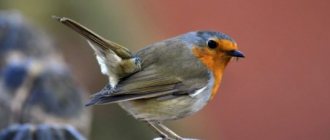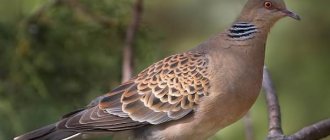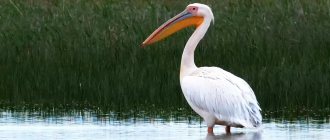Main characteristics of the species
The partridge is a bird whose size falls within the range between the domestic chicken and the pheasant. Sometimes adult birds in years with good feeding conditions reach sizes larger than domestic chickens. However, this occurs due to the accumulation of subcutaneous fat, which can quickly be wasted during winter without food. Visually, the size of this polar chicken increases due to good feather cover and a thick layer of down.
The parameters of the average representative of this species are as follows:
- The body shape is typical of a chicken, but with different proportions. It is more streamlined and squat.
- The body length from the tip of the tail to the beak is from 33 to 40 cm, the weight is less than a kilogram - from 500 to 800 g.
- The head and eyes are small, the neck is short.
- The beak looks strange for a herbivorous bird. It is short and curved down.
- The legs are also short, equipped with long fluffy feathers that act as snowshoes.
- The wings are small, which influences the flight pattern.
- A distinctive feature is the long and tenacious claws. Their purpose is to dig out snow and stay on the ground in strong winds.
The white partridge is a typical representative of the tundra and forest-tundra. In addition, this bird has found its ecological niche in the high-mountain tundra outside the forest zone.
Conservation status of the bird
The ptarmigan is a declining subspecies of pheasant birds. These birds are strongly attached to a certain type of habitat - raised sphagnum bogs. Only here they build nests and breed offspring. Unfortunately, the interests of living beings do not always coincide with the interests of man, who every year tries more and more to adapt wild nature for his own benefit. Draining of swamps, logging, fires, and general pollution of the natural environment with industrial waste are just some of the factors that actively influence the decline in the number of white partridges. Birds also suffer from poachers. Attempts to artificially rear partridges with subsequent reintroduction into their natural habitat have not yet been successful.
Lifestyle and nutrition
The polar bird partridge lives mainly in the tundra. However, it can also be found on trees in the forest-tundra zone. Sometimes it even flies into the zone of northern or mountain coniferous forests. This usually happens in years of famine.
This bird’s dislike for the forest is also due to the fact that it flies poorly. However, unfallen seeds may remain on the trees, while the entire tundra is already covered with snow.
The tundra partridge feeds mainly on plant foods. The summer diet of an adult bird consists mainly of leaves, berries, seeds, and flowers of plants. Chicks usually feed on insects, although they can also consume berries and leaves. The fact is that on animal proteins and fats, small partridges grow much faster, and then more easily endure the first wintering in their lives.
The white partridge lives in the tundra, mainly among the snow.
Adult birds feeding on plant foods are also seen in the summer eating some insects, worms and other invertebrate inhabitants of the tundra. This is a good way to store fat in order to more easily survive the winter cold.
This bird has a diurnal lifestyle. At night she hides in secluded places and sits there very quietly. In winter, it is completely buried in the snow. This habit saves the bird from cold, winds and predators. However, there is one danger in such a shelter. In spring, when temperature changes become contrasting, an ice crust may form on the snow. If a bird buries itself in the snow on a warm evening, and by the morning it freezes, then the bird risks being walled up in snow captivity, since it may not have enough strength to break the ice crust.
Reproduction
Nesting time is also tied to the region of habitat and climatic conditions. In the steppe regions, birds begin ovipositing in the last days of April, and in the Altai mountains, at an altitude of 2000 m, females lay eggs in May and June. If the weather conditions are unfavorable and the warmth does not come for a long time, the females do not begin laying eggs at all.
Chukars form pairs with the arrival of spring and build nests in the resulting thawed areas. Males often fight with each other for the highest and cleanest places. Throughout the incubation period, the owner of the territory drives other males away from his area.
Courtship begins only when the male ptarmigan has found a suitable site for the nest. During the lekking flight, it circles around the female, and the mating ritual consists of a song, special calls and movements, poses and freezing. Outside the breeding season, partridges very rarely scream, but during this period of time they become not only noisy, but also active. The clucking sounds of females are inferior in strength to the guttural exclamations of males.
Typically, a partridge's nest is located under hummocks, in tall grass or thickets, under boulders or in holes under tree roots.
Holes in the ground lined with stems and branches can also serve as nests. One clutch can contain from 5 to 20 small pear-shaped eggs. The shell changes color from ocher yellow to pale yellow during the incubation period. By the time the chicks hatch, the egg shell becomes dull and pale. Incubation lasts 3 weeks.
Chicks are born covered with down, capable of movement and independent search for food. Both parents take care of the offspring, and the babies remain under supervision for two months. A few hours after hatching, the brood of white chicks is transferred to shelter - dense thickets of reeds, bushes and berries. Sometimes several females unite their broods into one flock and roam the tundra in search of food. Babies develop quickly, and by the end of the summer period they catch up with their parents in size.
Spreading
Distributed circumpolarly - found in North America and northern Eurasia; found in the British Isles. In Russia it is found from the eastern shore of the Baltic Sea to Kamchatka and Sakhalin.
Inhabits the tundra, forest-tundra and northern taiga zone; in forests it is found mainly in moss swamps; in the mountains it reaches the subalpine zone. Individuals living in the marshy areas of England and especially Scotland, due to the milder climate, do not change their color, but throughout the year have a chestnut-brown summer dress with brown flight feathers and gray legs.
It is the symbol of the American state of Alaska.
Literature
- Madge S., McGowan P., Kirwan GM
Pheasants, Partridges, and Grouse: A Guide to the Pheasants, Partridges, Quails, Grouse, Guineafowl, Buttonquails, and Sandgrouse of the World. - Princeton, NJ: Princeton University Press, 2002. - 488 p. — ISBN 0-7136-3966-0. (English) - Kurochkin E.N.
Birds of Central Asia in the Pliocene // Tr. joint Sov.-Mong. paleont. forwarding 1985. Vol. 26. P. 1-119. - Zelenkov N.V., Kurochkin E.N.
Neogene pheasants of Central Asia. 2. Genera Perdix, Plioperdix and Bantamyx // Paleontological Journal, 2009, No. 3, p. 79-86. - Kozlova E. V.
Birds of zonal steppes and deserts of Central Asia. Proceedings of ZIN. T. 59. L., 1975.
Lifestyle
Partridges gather in small flocks of 10-15 individuals and form pairs only during the breeding season. These birds lead a terrestrial lifestyle. Due to their color they are easily camouflaged. They are awake during the day and hide in dense vegetation at night. Partridges fly very rarely, and even then only over short distances. Its main method of movement is fast running.
This bird is very careful. Looking for food, she moves carefully and almost silently, looking around from time to time. Sensing danger, it first freezes, letting its enemy get closer, and then suddenly takes off sharply. Before migrating, birds gather in large flocks, which can consist of 200-300 individuals.
Interesting facts about partridges
This article contains a lot of interesting information about partridges, but below we will give a few more facts that many people may not know:
- Partridges can go into torpor if they sense danger.
- Partridges rarely live past four years of age because there are too many predators to hunt them in the wild. However, if the situation is favorable, they can live 11–13 years.
- The coat of arms of the Kursk region depicts three flying gray partridges.
- According to the etymological dictionary of G. A. Krylov, the word “partridge” was formed due to the combination of “chicken” and “p’ta” - bird.
- The white partridge has a constant body temperature of 45 °C, and it does not change even in severe cold.
- In some regions, male partridges are called “drummer” or “pitun”, and females are called “talovka” or “birch”.
- There is a sign that if partridges come closer to people for the winter, the winter will be harsh.
- If you look at the photo with ptarmigan in winter, it will be difficult to find them. White plumage is a kind of camouflage for the partridge, saving it from predators.
- The number of Central Russian white partridge is decreasing due to the drainage of swamps and peat extraction. To preserve the “swamp” partridge, specially protected natural areas of the Sestroretsk swamp have been created.
- Gray partridge chicks can take to the air within a week after birth.
Mating season
When spring comes, the male changes: his head and neck change color and become reddish-brown. During the mating season, the bird can be recognized by the ringing, sharp sounds it makes. They are accompanied by peculiar “dances”, which are complemented by flapping and loud flapping of wings. The male partridge becomes aggressive and often rushes into a fight against his own relatives who dare to violate his territory.
The female's behavior also changes. If previously she was of little interest to representatives of the opposite sex, now she herself is trying to find a mate. Having mated, the female begins to build a nest alone. The place is usually chosen somewhere under a hummock, hiding in bushes or among other tall plants. There she digs a hole and then lines it with her feathers, branches, leaves and stems of plants nearby.
The ptarmigan begins laying eggs no earlier than the end of May. They are usually painted pale yellow with variegated specks on them. One female is capable of laying about 8-10 eggs. The incubation process is quite long and lasts at least 20 days. Only the female does this, without leaving the nest for a minute. The male protects his girlfriend and future chicks.
Nesting sites
In the middle zone of our country, it nests in mossy swamps covered with rare low-growing pines, birch small forests or shrubs, with an undergrowth of heather, wild rosemary, wild rosemary with the presence of blueberries, lingonberries, cranberries, cloudberries and other berries.
The nest is made in the swamp itself or on its outskirts, choosing a more or less dry place for this. At the same time, it avoids dense bushes, preferring open areas so that the bird sitting on the nest can view the surrounding area.
The nest is located on the ground under the cover of small clumps of grass or single branches of bushes and berry fields. For lining she uses dry stems and twigs of herbs and shrubs, sometimes a few feathers. The nest is a small depression in the soil, cleared by the bird, rather poorly lined with dry stems and twigs of grass and shrubs, sometimes with a few feathers. Nests located on moist soil have more abundant litter. Nest dimensions: tray diameter 90-190 mm (average about 170 mm), tray depth 40-80 mm (average about 60 mm).
Photo gallery
Photo 1. Two snow-white beauties on the bark of a tree
Photo 2. Partridge in summer
Photo 3. A flock of birds in winter
Photo 4. Close-up of a bird in spring
Photo 5. A resident of the tundra sits on a branch
Photo 6. Close-up of a bird in the snow
What does it look like in winter
The white partridge has a beautiful appearance, regardless of the time of year. But, thanks to the phenomenon of seasonal dimorphism, in winter the outer tail feathers differ from its snow-white plumage. They take on a black tint. If you pay attention to the legs, they will be shaggy, densely covered with short feathers. Such features of the bird's outfit in winter allow it to blend into the environment and become almost invisible to predators in order to survive in the wild nature of the tundra and other areas.
In spring, the neck and head of the male acquire a brick-brown color; for this reason, they create a sharp contrast with the body.
